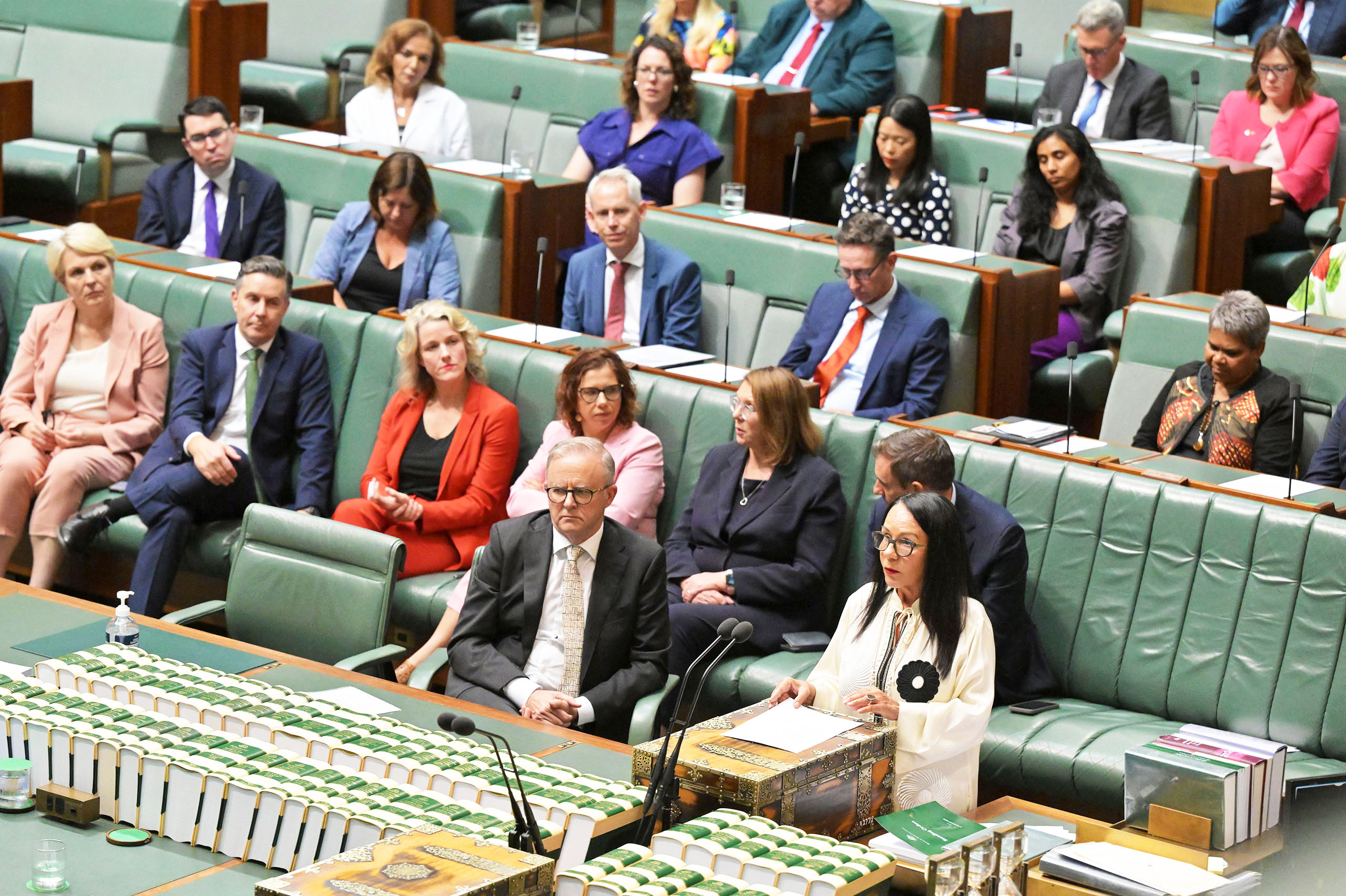Governments acknowledge year after year that policies designed to close the gap aren’t working, yet they refuse to allocate the intellectual, financial and political resources that would make a difference. Instead, they devote enormous bureaucratic and political resources to managing the perceptions of the wider electorate, raising and then dashing expectations in First Nations communities and laying the foundations for deeper distrust and disengagement.
The problem is clear in the latest Closing the Gap annual report, a masterful example of sophisticated political management and bureaucratic obfuscation. This tightly organised combination of new and previous policy commitments, 2023 achievements and key actions for 2024 purports to outline the Commonwealth’s strategic priorities for the next year. But closer analysis reveals deep-seated flaws in policy design, strategic omissions and evasions and a deep-seated lack of ambition, all wrapped in a slick presentation replete with selective case studies, graphics, some useful governance charts and an avalanche of uninformative facts and figures. There is nothing strategic about this document.
The previous government was more inclined to blame the victim, cut funding and pursue punitive policies. It reshaped the Closing the Gap architecture, reconstituting and expanding its targets. Most importantly, it created a new National Agreement on Closing the Gap that directly engaged First Nations in shaping policy while shifting the bulk of political and policy responsibility — and future blame — to the states and territories.
For Labor, the failure of the Voice referendum has exposed a deficient policy framework and diminished its preparedness to pursue substantive reform. In desperation, it has fallen back — holus bolus — on the previous government’s policy architecture.
Despite their tactical and ideological differences, both major parties have used excessively complex bureaucratic processes, extremely low transparency, high-flown promises and the tactical politicisation of specific issues to divert attention from more important underlying issues. Their guiding principles appear to be to deflect, defer and delay.
A fundamental problem with the national agreement is that its policy architecture is extraordinarily over-engineered. It was designed not by a single committee of state, territory and Commonwealth bureaucrats but by negotiations between that committee and a committee of Indigenous representatives. The asymmetric power imbalance inevitably produced an imperfect structure.
It is hard to believe that the government negotiators didn’t see the ramifications of the extraordinarily complex structure that emerged from the negotiations. It created multiple choke points at which multi-party consultation and coordination is required, encouraging a culture of inertia and stasis.
To take just one important example, the agreement identifies nineteen targets and four priority reforms and allocates responsibility for implementation to eight state and territory jurisdictions along with the Commonwealth and the Australian Local Government Association. The Coalition of Indigenous Peaks — which itself has a nascent federal structure in each state and territory — is also ostensibly an equal partner.
No line of sight nor responsibility exists between any one target and any one government or minister: responsibilities and accountability are shared across a highly complex geographical and sectoral matrix involving layers of mainstream and Indigenous-specific programs. National-level data is deficient across all targets and all four priority reforms, at least partly because the targets themselves have been poorly chosen and loosely specified. Most importantly, the targets are not aligned with dedicated investment strategies.
The four priority reforms at the heart of the agreement would best be seen as overarching frameworks. But they have been broken down into arbitrary elements to be measured and reported on, notwithstanding the vagueness of these elements and their poor fit with existing data. Instead of bringing macro-level strategic coherence the four priorities have been converted into arenas of micro-focused navel-gazing.
While the agreement requires each jurisdiction to publish an annual report and develop an on-going implementation plan, the joint council that manages its operation decided some years ago to shift to annual implementation plans, adding a further layer of process. Instead of being a roadmap laying out each jurisdiction’s multi-year pathway to each target, the plans merely recount innumerable actions and funding decisions, most with limited timeframes.
The latest Commonwealth implementation plan lists sixty-five commitments of varying significance; state and territory plans are generally much more complicated. A requirement that jurisdictions explain how they would “close the gap” has been transformed into a requirement to publish a profusion of meaningless facts and intentions to develop plans.
By combining that latest implementation plan with its annual report the Commonwealth has signalled its unwillingness to develop and lay out a longer-term roadmap. Its decision-making is very much at odds with the recent Productivity Commission review of Closing the Gap, which recommends that implementation plans reflect a more strategic approach.
Any serious attempt to lay out such a roadmap would involve two elements that are seemingly anathema to the Australian government. First, the Commonwealth would need to establish a framework to coordinate the disparate and largely inadequate efforts of the states and territories. This is a glaring hole in Closing the Gap’s architecture and desperately needs attention not just from the Indigenous Australians minister but also from the treasurer, the finance minister and the prime minister.
Notwithstanding its potential to give First Nations people access to policymaking, the national agreement has formalised a regression across the federation towards the inertia last experienced before 1967. Labor would face few insurmountable obstacles if it resolved to reverse direction and effectively coordinate government efforts to deal with Indigenous disadvantage across the federation. A failure to do so will risk Closing the Gap imploding under its own weight.
The second element of a realistic and effective roadmap would be an estimate of the size of the multi-year investments required. This would facilitate better decision-making, assist in placing the myriad demands on governments in perspective and assess the financial costs — the imputed shortfalls in funding, in other words — that First Nations Australians continue to bear.
Unfortunately the Commonwealth’s latest implementation plan appears designed to preclude even modest reforms like these.
Many other questions and issues aren’t dealt with in the Commonwealth’s plan. There’s space here to look at just two of them.
The Community Development Program provides income support and job search for around 40,000 participants in remote Australia. This year’s Closing the Gap annual report lists a total 1950 new jobs employment placements/jobs created under CDP. Even so, the prime minister announced that the government was “moving on” from the “failed Community Development Program” and establishing a Remote Jobs and Economic Development Program to help community organisations create 3000 jobs over three years in remote areas, at a cost of $707 million. This funding for real jobs in regions where employment opportunities are scarce or non-existent is welcome and long overdue. Unfortunately, it is pathetically unambitious. And what is the future for the 37,000 CDP participants? Will they continue in a “failed” program?
A second example: the report lists ninety-eight actions from last year’s implementation plan and reports on their status. Most are mere process matters. Nine are listed as delayed; one as “stopped.” The latter is target 9b, relating to remote essential services infrastructure (though that’s not spelt out in the report). The target, which was approved by ministers in August 2022, states:
By 2031, all Aboriginal and Torres Strait Islander households:
• within discrete Aboriginal and Torres Strait Islander communities receive essential services that meet or exceed the relevant jurisdictional standard
• in or near to a town receive essential services that meet or exceed the same standard as applies generally within the town…
Last year the Commonwealth declared that “delivering on Target 9b will provide vital infrastructure to support liveable, safe, sustainable and healthy communities for all First Nations peoples… The initial focus for the target will be on the development of a new Community Infrastructure Implementation Plan, in collaboration with the National Aboriginal Community Controlled Health Organisation (NACCHO) and key stakeholders.”
Why then, without explanation, has work on the implementation plan for “vital infrastructure” been stopped? Perhaps the Commonwealth fears a remote infrastructure implementation plan would encourage the states to demand increased Commonwealth funding. So much for mobilising all avenues and opportunities to overcome the entrenched inequality faced by too many Aboriginal and Torres Strait Islander people.
All in all, the latest Closing the Gap report makes for depressing reading. It comes across as a convoluted box-ticking exercise, overflowing with plans, partnership committees, good news stories and the like. It makes no serious attempt to look behind the available data to acknowledge and reflect on the challenges of those families caught up in extreme poverty, cycles of alcohol-and drug-induced despair, youth suicides, and the trauma of extraordinary rates of incarceration and unfathomable out-of-home-care rates for Indigenous children.
The report’s implicit agenda is to defer committing financial resources, and delay making difficult decisions. Sure, governments can’t solve all the nation’s problems, but it is inexcusable that, where governments do invest, resources don’t flow equitably.
The Closing the Gap process is perhaps the most useful way to bring these problems to the nation’s attention. Its success will require vision, political commitment and a preparedness to think through the policy issues and make decisions commensurate with the size and severity of the challenges. The Albanese government, like the government before it, has so far failed on all counts.
In his 1963 “Letter from Birmingham Jail,” Martin Luther King Jr. famously wrote that “justice too long delayed is justice denied.” It is time the government commissioned an independent strategic review of the Indigenous policy domain, akin to the recent 2023 Defence Strategic Review, aimed at bringing a much greater degree of discipline, rigour and, most importantly, urgency to a worsening crisis blighting the life opportunities of many tens of thousands of First Nations citizens.
The fact that the depth and severity of this crisis is largely invisible to most Australians increases the responsibility on governments to act; it is not an excuse or rationale for inaction. •




